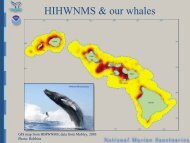The First International Conference on Marine Mammal Protected Areas
The First International Conference on Marine Mammal Protected Areas
The First International Conference on Marine Mammal Protected Areas
You also want an ePaper? Increase the reach of your titles
YUMPU automatically turns print PDFs into web optimized ePapers that Google loves.
catalysts, partners, or support systems for impact research and mitigati<strong>on</strong><br />
strategies at regi<strong>on</strong>al, nati<strong>on</strong>al, and internati<strong>on</strong>al levels.<br />
• Bycatch is a major threat to marine mammals worldwide. If fishery regulati<strong>on</strong>s<br />
do not address the bycatch problem adequately, MMPAs with no-fishing z<strong>on</strong>es<br />
offer an alternative to regular fishery management.<br />
• For management, advisory councils can be used as part of a strategy for engaging<br />
stakeholders. Expert advisory groups can help ensure that appropriate scientific<br />
expertise is applied to the design of research projects and m<strong>on</strong>itoring programs.<br />
• More attenti<strong>on</strong> must be devoted to management plans: developing and updating<br />
them to make them more effective and sharing “best practices” between<br />
MMPAs in an MMPA network to guide future work, as well as developing and<br />
sharing methods of evaluati<strong>on</strong>.<br />
• Guidance needs to be developed for integrating c<strong>on</strong>venti<strong>on</strong>al marine<br />
management tools with MMPAs/MMPA networks to achieve c<strong>on</strong>servati<strong>on</strong>.<br />
Which tools are best applied, al<strong>on</strong>e or in combinati<strong>on</strong>, under what<br />
circumstances?<br />
• In terms of establishing MMPAs and levels of protecti<strong>on</strong> and z<strong>on</strong>ing, marine<br />
mammal scientists should not be forced to become advocates. Rather, they<br />
should be encouraged to describe and quantify trade-offs and present choices so<br />
that decisi<strong>on</strong> makers can evaluate opti<strong>on</strong>s.<br />
• As part of networking, a str<strong>on</strong>g effort should be made to transfer skills and<br />
resources to researchers and management staff in less developed countries, thus<br />
increasing their capacity to obtain the data necessary to develop and manage<br />
MMPAs. A website with extensive resources and mentoring c<strong>on</strong>tacts should be<br />
set up as part of this, and teams of experts in the various aspects of MMPAs and<br />
network building could visit sites in order to teach and help measure<br />
effectiveness.<br />
• <str<strong>on</strong>g>The</str<strong>on</strong>g> <str<strong>on</strong>g>C<strong>on</strong>ference</str<strong>on</strong>g> supported the research goals and, in particular, the cooperative<br />
approach of the Southern Ocean Research Program (SORP).<br />
• MMPAs should become centers for research innovati<strong>on</strong> and creativity in terms<br />
of solving marine mammal c<strong>on</strong>servati<strong>on</strong> problems, and the knowledge thus<br />
generated should be shared as widely as possible. (Good examples are the<br />
development of acoustic m<strong>on</strong>itoring at Stellwagen Bank and the suite of<br />
techniques used to study as well as to help free gear-entangled humpback<br />
whales.)<br />
• Noise c<strong>on</strong>siderati<strong>on</strong>s should be incorporated into management plans of MMPAs<br />
through, for example, the use of buffer z<strong>on</strong>es. <str<strong>on</strong>g>Internati<strong>on</strong>al</str<strong>on</strong>g> or nati<strong>on</strong>al (EEZ)<br />
cetacean sanctuaries, or areas without formal protecti<strong>on</strong>, could add noise-related<br />
spatio-temporal restricti<strong>on</strong>s to their array of protecti<strong>on</strong> measures. Diversi<strong>on</strong> of<br />
shipping lanes or limits <strong>on</strong> ship speed also may reduce the exposure of cetaceans<br />
to noise. L<strong>on</strong>g-term visual and passive acoustic m<strong>on</strong>itoring of cetaceans, and<br />
m<strong>on</strong>itoring of noise levels, are particularly important in MPAs.<br />
• A major challenge in MPA design is to accommodate diverse oceanic habitats<br />
(static, persistent, or ephemeral) that are critical for marine mammals and their<br />
food webs. This requires spatially explicit marine z<strong>on</strong>ing and c<strong>on</strong>servati<strong>on</strong>.<br />
Upper trophic-level oceanic predators make their living in a vast, dynamic, and<br />
ICMMPA <str<strong>on</strong>g>C<strong>on</strong>ference</str<strong>on</strong>g> Proceedings<br />
x



